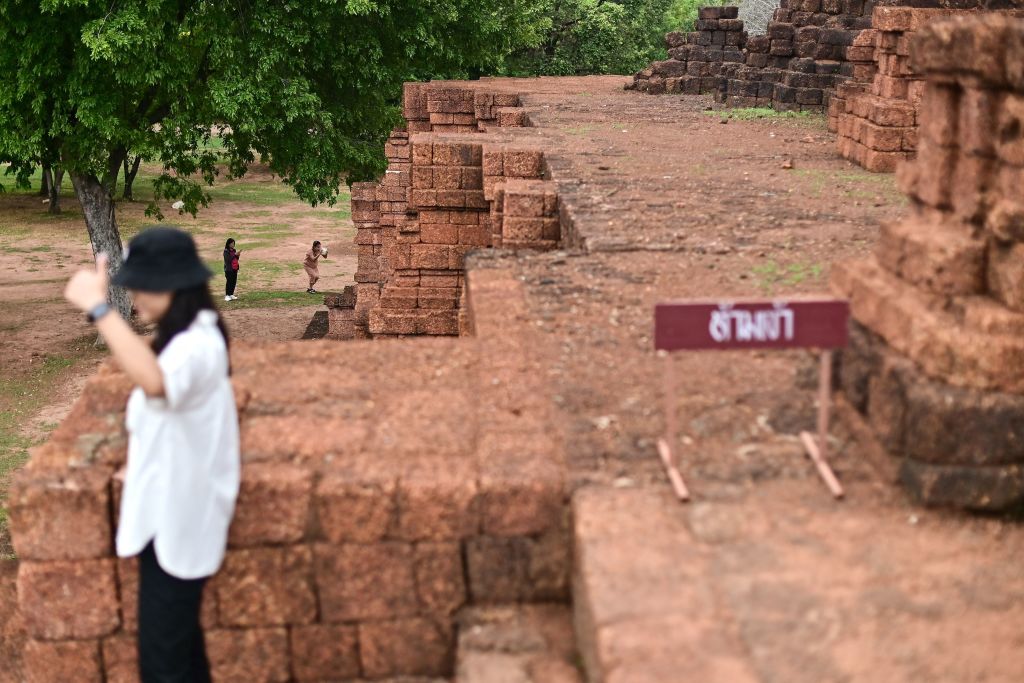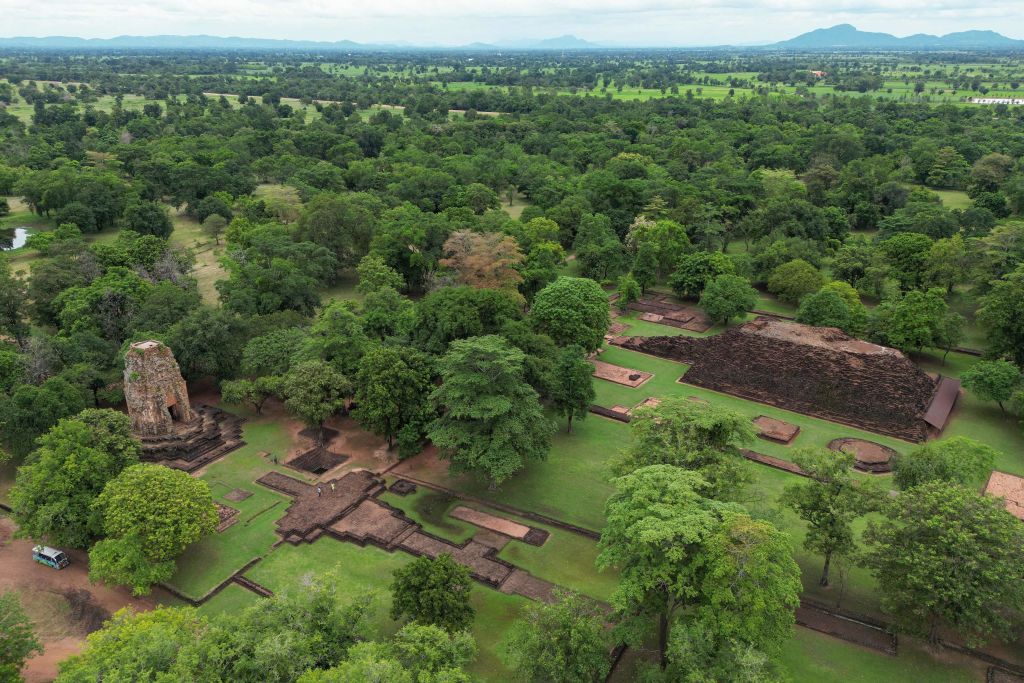
The Khao Klang Nok monument in Si Thep, an ancient town 150 miles north of Bangkok, has survived more than a thousand years as kingdoms and empires rose and fell around it. But in just the week since the terraced temple and its surrounding area was named a World Heritage Site by the United Nations Educational, Scientific, and Cultural Organization (UNESCO), Thai authorities have grown worried about its future.
The designation, Thailand’s first cultural site listing in more than 30 years, has transformed what was a sleepy historical park into one of the country’s hottest tourist destinations. But to locals’ dismay, hordes of new visitors have taken to climbing up the park’s most iconic ruins: a 20-meter-tall collapsed laterite stupa containing sacred Buddhist relics. Authorities have decried the act as inappropriate and pointless, and are now considering restricting access to the structure, which has long been free for visitors to roam.
“Personally, I think a ban would make this ancient place more valuable,” Si Thep district chief Weerawat Wattanawongphreuk told local media on Tuesday. “Going up to the top is nothing. People just want to take pictures of the scenery. It is better to stay below and view this ancient place.”
Since the 1,500-year-old complex was declared a UNESCO World Heritage Site on Sept. 19, the Si Thep Historical Park and adjacent Khao Klang Nok monument have been met with an influx of tourism: about 20,000 visitors came last weekend, park authorities estimated, noting that the boom exceeded their expectations.
The ancient ruins of Si Thep were listed as a national archaeological site in 1935. Over the years, locals and archaeologists uncovered artifacts, including stone inscriptions and artwork, that reflect a range of influences including Hinduism, Mahayana Buddhism, the Khmer Empire, and the ancient Southeast Asian kingdom of Dvaravati, and that shed light on what started as a prehistoric farming village and later thrived as a vibrant hub of commerce and culture before eventually fading as modern Thailand developed around a new political center. But despite its rich history, the area remained relatively quiet until last week.
For Thailand, which has been trying to revive its battered tourism industry after the pandemic, the recognition of The Ancient Town of Si Thep and Its Associated Dvaravati Monuments, as it’s officially listed by UNESCO, was celebrated by officials as a much-needed boost that, according to a statement by the foreign affairs ministry, “brings great pride to the Thai people.”

It’s Thailand’s seventh World Heritage Site—joining three other cultural heritage sites and three natural heritage sites—and the country’s newest cultural addition to the list since the Ban Chiang Archaeological Site was included in 1992. Globally, there are more than 1,000 World Heritage Sites.
But while Prime Minister Srettha Thavisin expressed his “deepest gratitude” to UNESCO for the recognition, experts have been worried that Si Thep is not prepared for the surge of attention its new status would draw.
The area lacks adequate infrastructure—from waste management to parking spaces—to accommodate large numbers of tourists, Phacharaphorn Phanomvan, a heritage development scholar at Chulalongkorn University and an advisor to a cultural council on Si Thep, said at a press conference in Bangkok last week. She added that the UNESCO listing, which will drive up the value of Si Thep’s artifacts on the black market, may also encourage theft from the park, which “was already one of the most looted sites in Thailand in the 1970s and 1980s.”
Questions are also being raised about what conservation efforts could mean for the local community. Phacharaphorn wrote in an op-ed on Thursday that some villagers in Si Thep who are caught in unresolved land disputes with the state may lose their homes as a result of the government’s land reclamation plan; others could have their livelihoods threatened by potential bans on livestock farming, a traditional practice in the region, in the name of protecting the site. (Residents have already stopped growing crops upon instructions from authorities, she noted).
And of course, there’s the threat of overtourism, which has already wreaked havoc on some of the world’s most famed cultural destinations and natural landscapes and which experts say may transform Si Thep in similar ways.
Read More: The World Heritage Hustle: Why Being On UNESCO’s List Can Be a Curse
“If it is not managed properly, tourism can threaten the conservation of Si Thep,” Sarinya Sungkatavat, a lecturer of international tourism and hospitality management at Mahidol University, tells TIME. “I have seen so many ancient destinations, whether they are named [a] UNESCO World Heritage Site or not, [where] excessive visitation caused damage to the site—[by] erosion, vandalism, or theft, for example.”
Authorities need to step up, says Sarinya, to make sure that visitors to the heritage site are limited and that they observe proper etiquette. “It is very important to implement sustainable tourism practices that minimize these negative impacts and maximize the positive impacts of tourism on the site and its host communities.”
Some officials are blaming Si Thep residents for not capitalizing on the unprecedented traffic. “It’s truly unfortunate that the local community couldn’t catch up in time, resulting in no facilities or services to benefit from the significant influx of tourists,” Phetchabun Governor Wison Kositanont, who was a key advocate for the UNESCO designation, said in a Facebook post on Saturday.
But it’s not just a matter of assigning blame. There’s a risk that if the growing problems aren’t addressed, Si Thep could lose its prized title. While rare, World Heritage Sites can be delisted if UNESCO finds them to be improperly managed. In 2021, the city of Liverpool was stripped of its World Heritage status after UNESCO found that the historic value of the city’s docks—once a trading hub in the 18th and 19th centuries—had suffered an “irreversible loss” due to development. Only two other places have been similarly struck off the UNESCO list: the Arabian Oryx Sanctuary in Oman (delisted in 2007 after the government drastically reduced its size upon discovering oil at the site) and the Dresden Elbe Valley in Germany (delisted in 2009 after the government built a bridge that cut through the landscape).
“Maintaining a World Heritage Site is harder than being declared one,” Jatuporn Buruspat, Thailand’s secretary of natural resources and environment told the press on Sept. 19 in Riyadh, where UNESCO announced its latest listees. “Local residents and the general public have a part to play.”
More Must-Reads from TIME
- Donald Trump Is TIME's 2024 Person of the Year
- Why We Chose Trump as Person of the Year
- Is Intermittent Fasting Good or Bad for You?
- The 100 Must-Read Books of 2024
- The 20 Best Christmas TV Episodes
- Column: If Optimism Feels Ridiculous Now, Try Hope
- The Future of Climate Action Is Trade Policy
- Merle Bombardieri Is Helping People Make the Baby Decision
Contact us at letters@time.com